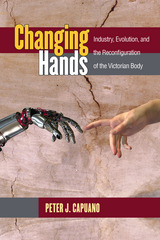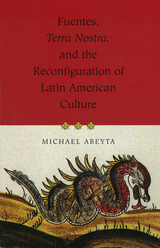4 books about Reconfiguration

Changing Hands
Industry, Evolution, and the Reconfiguration of the Victorian Body
Peter J. Capuano
University of Michigan Press, 2015
In Changing Hands, Peter J. Capuano sifts through Victorian literature and culture for changes in the way the human body is imagined in the face of urgent questions about creation, labor, gender, class, and racial categorization, using “hands” (the “distinguishing mark of . . . humanity”) as the primary point of reference. Capuano complicates his study by situating the historical argument in the context of questions about the disappearance of hands during the twentieth century into the haze of figurative meaning. Out of this curious aporia, Capuano exposes a powerful, “embodied handedness” as the historical basis for many of the uncritically metaphoric, metonymic, and/or ideogrammatic approaches to the study of the human body in recent critical discourse.
[more]

Fuentes, Terra Nostra, and the Reconfiguration of Latin American Culture
Michael Abeyta
University of Missouri Press, 2006
Widely acknowledged as Carlos Fuentes’s most ambitious novel, Terra Nostra is a paradigm-shifting work that has generated a virtual cottage industry of scholarly analysis. Michael Abeyta has now taken a new approach to this celebrated novel by considering how giving a gift is like telling a story.
Grounding his study on the work of Derrida and Bataille, Abeyta focuses on the theme of the gift in Terra Nostra, analyzing how gift giving, excess, expenditure, sacrifice, and exchange give shape to the novel. The question of giving leads him into contemplations of such parallel issues as money and exchange economies, the gift’s role in art and narration, and the Baroque in Latin American culture—an elaborate set of arguments that puts Fuentes’s understanding of Latin American culture in a surprising new light.
Blending literary theory with economic anthropology, philosophy, and Latin American studies, Abeyta analyzes the deconstructive functions of rhetorical figures and tropes in Terra Nostra to show how the novel’s revival of Baroque style integrates European and Nahuatl figural strategies. In the process, he reveals the novel’s relevance to current discussions about the relationship between art and the question of the gift. He then goes on to examine Fuentes’s Baroque in relation to Terra Nostra’s reconfiguration of Latin American cultural history.
Abeyta’s study opens new windows on this difficult work as he grapples intelligently with the sometimes dizzying conceptual dances that Fuentes performs. He shows how Fuentes’s rereading of Latin American history confronted important changes during the initial encounter between Europe and the Americas, which coincided with the spread of the European market and the shift from a gift to an exchange economy—from a culture in which economic relations were based on sacrifices, tributes, or gifts to one in which market forces predominated. He also engages in the recent scholarly debate on the potlatch and its implications in New World culture.
As Abeyta reveals, underlying Fuentes’s treatment of the gift is a deep questioning of utopian thought and its impact throughout Latin America’s history. His insights help define Terra Nostra’s place in current discussions in literary theory about art, economy, and the question of the gift, and this work stands to be hailed as one of the most perceptive readings of the novel yet to appear.
[more]

Ishikawa Sanshir.’s Geographical Imagination
Transnational Anarchism and the Reconfiguration of Everyday Life in Early Twentieth-Century Japan
Nadine Willems
Leiden University Press, 2020
Antiestablishment ideas in contemporary Japan are tied closely to its recent history of capitalist development and industrialization. Activist Ishikawa Sanshiro exemplifies this idea, by merging European and Japanese thought throughout the early twentieth century. Ishikawa Sanshiro’s Geographical Imagination investigates the emergence of a strand of nonviolent anarchism and uses it to reassess the role of geographic thought in modern Japan as both a tool for political dissent and a basis for dialogue between radical thinkers and activists from the East and West. By tracing Ishikawa’s travels, intellectual interests, and real-life encounters, Nadine Willems identifies a transnational “geographical imagination” that valued ethics of cooperation in the social sphere and explored the interactions between man and nature. Additionally, this work explores anarchist activism and the role played by the practices of everyday life as a powerful force of sociopolitical change.
[more]

Professionals under Pressure
The Reconfiguration of Professional Work in Changing Public Services
Edited by Mirko Noordegraaf and Bram Steijn
Amsterdam University Press, 2013
Over the past decade, public services have come under increasing pressure to perform like private-sector organisations. This study demonstrates that professionals have much leeway in coping with changes caused by IT developments, distributed knowledge and more demanding public which have all created new pressures on public services. The authors conclude that rather than demanding more autonomy and space, public service professionals need renewed and workable professional standards.
[more]
READERS
Browse our collection.
PUBLISHERS
See BiblioVault's publisher services.
STUDENT SERVICES
Files for college accessibility offices.
UChicago Accessibility Resources
home | accessibility | search | about | contact us
BiblioVault ® 2001 - 2025
The University of Chicago Press









